If you knew how to publish content that ranks on Google, would that change your business? There’s no one in this world (with a website) who doesn’t want to be at the top of Google for the keywords of their choice.
Whether you already have a website, a business, or just an idea floating around in your head-ranking for the right keywords will make you money as long as you have the right offering.
Ranking on Google is a proven way to attract a lot of website visitors that are looking for what you offer. The good news is it’s not a magic trick. It’s a valuable skill that you can learn with a little research and a proven process.
Did you know that more than 90% of all businesses are now investing in some form of content marketing? SEO and content marketing are practically synonymous with one another. This combination is one of the top B2B marketing strategies because the ROI is incredibly high. It’s impossible to ignore the earning power of Google and other major search engines when it comes to leads generation and sales.
The bottom line is that when you publish content that is original, useful, entertaining, and worth sharing it’s bound to surface near the top of the search results. Not everyone can publish an award-winning literary masterpiece, but you don’t have to when you follow a basic template for publishing SEO content.
SEO and content marketing go hand in hand. You can plan to appear at the top of the search results with a little research and a calculated effort. But before we start…
A word about SEO content
Table of Contents
- 1 A word about SEO content
- 2 Publish what people are looking to find
- 3 Content Creation
- 4 Optimize your content
- 4.1 Place your keyword in the title (the title should have an H1 heading)
- 4.2 Your keyword should appear in the first paragraph or first 100 words
- 4.3 Repeat your keyword at least two or three times within the body
- 4.4 The image alt tags need to have your keyword (and variations of it)
- 4.5 Include a meta description to describe your article in the search results
- 5 Build links to improve the ranking ability
- 6 Final thoughts
Just to be clear, SEO content is any form of content that is optimized for specific keywords. This means it could be a landing page, an image, an infographic a product page, etc. In the following steps, you are going to learn how to plan and publish articles that rank.
This is especially beneficial for building traffic to your website through a blog, which is a major aspect of traffic generation. This is the very same template used by every SEO company and consultant (give or take a few tricks) and the following steps are proven to get your content to the first page of Google.
Publish what people are looking to find
You could be the most gifted person in your industry but if you’re not publishing content people are actively searching for, you won’t generate much traffic. The first step to a successful piece of content is to make sure the topic you’ve chosen is something that generates enough interest. Keyword research is an underrated and powerful aspect of how to publish content that ranks on Google.
Make a list of topics from your seed keywords
Make a list of potential topics based on your main products or services. For example, if you sell pool tables, consider publishing content about the following topics:
- The rules of 8 Ball pool
- Dimensions of a pool table
- How to move and set up a pool table
- How to change the felt on a pool table
- How much room do I need for an 8 ft pool table?
The idea is to come up with questions, issues, problems, and content that people would not only find useful but also lead them to purchase a pool table from you. If not now, then possibly in the future.
In most cases, the keywords should hold potential business value but there are times when they will simply serve other purposes (building trust, resources for clients, etc.)
Identify vital keyword metrics
A very important part of your planning is to identify the volume of monthly searches and the difficulty of ranking at the top of the search results. Assessing the cost per click is also useful but it’s not going to make or break your decision since it only provides insight into the commercial value.
To find these metrics you will need a keyword tool. In the examples shown below the tool being used is SEMrush, which offers a free version (with some limitations).
Assess the monthly search volume
This part of your planning is critical to generating traffic. You need to see whether the keywords are even worth pursuing. The volume can be tricky because you need to decide on how many visitors a month will make an impact on your business. Enter your keyword into any keyword tool of your choice.
If your search term only gets 30 searches a month you need to understand that’s ONE person a day (on average) that searches for that term. If you’re not in the number one spot you won’t be seeing much traffic. You should however look for different variations for better search volume.
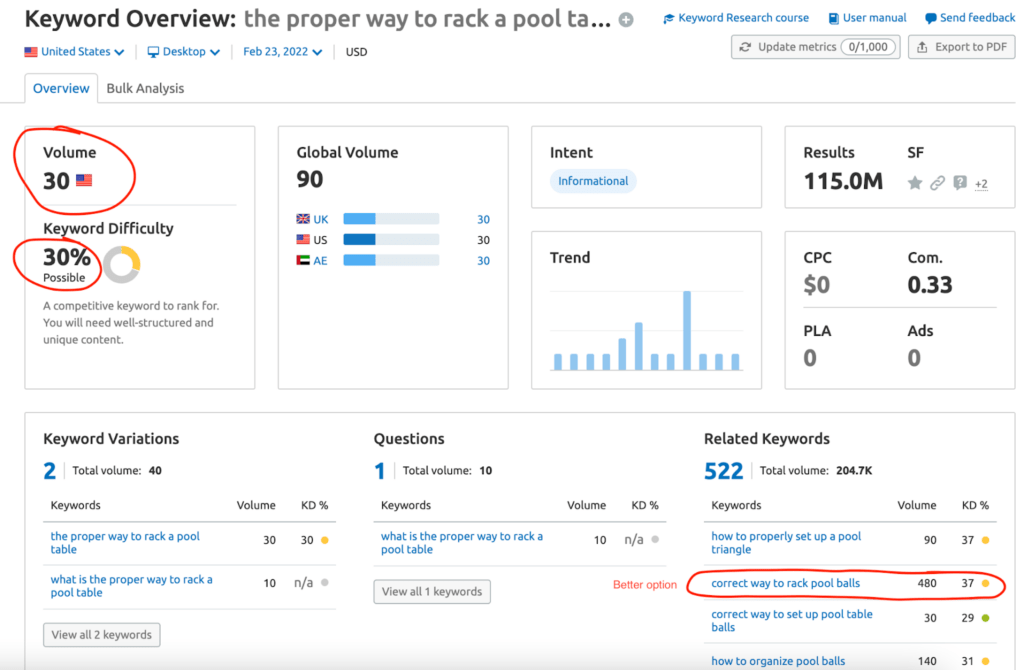
On the flip side of the coin, when you rank in the number one position you tend to rank for a great many different variations of your keyword. To find out how much traffic your search term is worth search for the keyword on Google.
Click on the #1 website in the organic results and copy the URL.
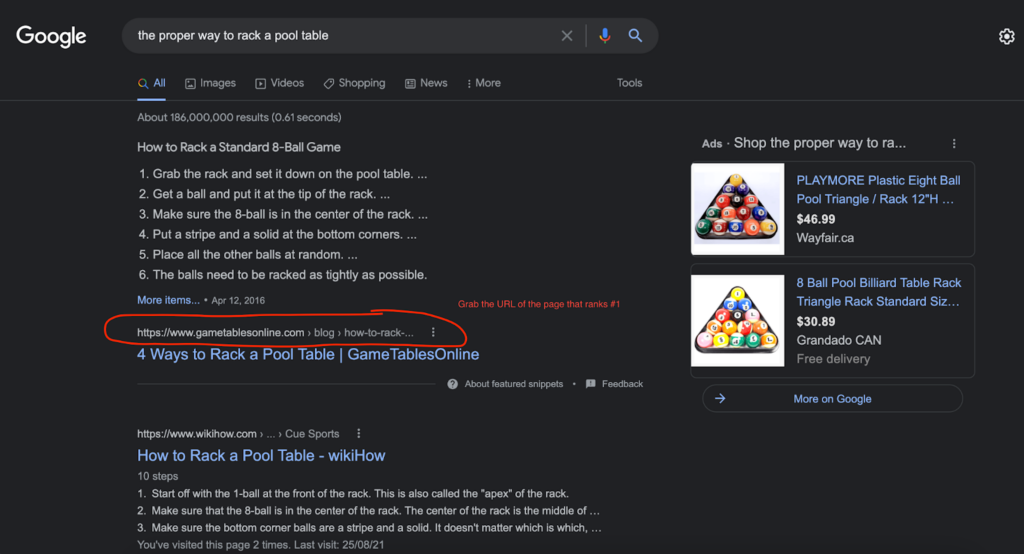
Enter the URL into SEMrush to see what traffic the page is generating

This insight not only gives you a clearer idea of what traffic you could potentially receive but also may lead to some more great keyword ideas. You can use the keywords your competition is using if they aren’t too difficult to rank for.
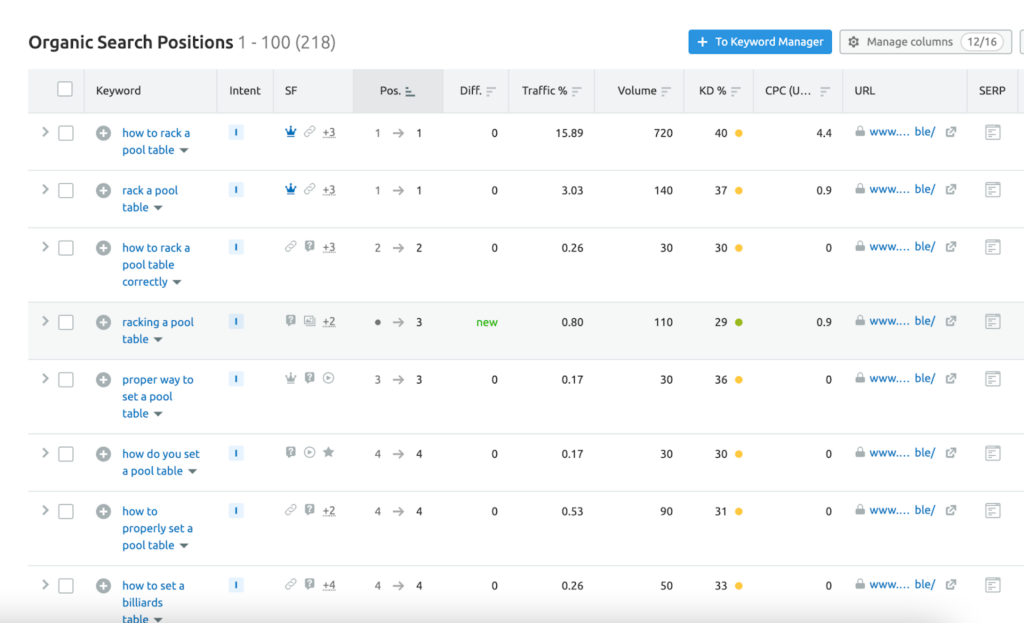
Assess keyword difficulty
The success of your content can be delayed quite a long time if the competition is difficult. For the most part, you want a keyword that can be ranked in a relatively short period. Obviously, the value of the keyword may determine how long it takes to rank but for the most part (especially if you’re not an SEO) you don’t want to have to build a lot of links to your page.
Most keyword tools will provide a metric for keyword difficulty. Stick to easy keywords if you’re a newbie and the furthest you will ever venture is a medium difficulty keyword.

You can also assess the search engine result page (SERP) to see what websites currently hold the top 10 positions. If you’re competing against Wikipedia, Forbes, Entrepreneur, etc. it’s probably best to choose another keyword. The number of backlinks you need to beat them would be insane, along with absolutely riveting content.
Establish search intent and content type
BY now, you’ve found the keyword that you can rank for that has a decent amount of monthly search volume. Your research hasn’t ended yet. The next step is to make sure you understand EXACTLY what people are looking for when they search your keyword. You confirm this by assessing the top 10 results on the SERP for intent and content type.
Search intent
Establishing search intent (aka user intent) is pinpointing what people are expecting to find when they type in a keyword. Make sure you’re on the right track by briefly reading through the top pages that rank for your keyword. You’ll get a sense of what the pages offer, the quality of the content, and the depth of the topic.
Content-type
Keep in mind that you’re trying to rank on a search engine. Google operates on an algorithm so it will always show web pages that it believes best answer search intent. The point here is that the content type tends to be very similar among the top-ranking results.
It only takes a quick glance to identify the content type that ranks best. It’s not that you can’t come along and do something completely unique and rank #1. You can. But why try to reinvent the wheel when you can make a safer bet on doing what’s already working.
Here are a few examples of content-type:
- Listicles
- Questions
- Ultimate Guides
- How-to articles
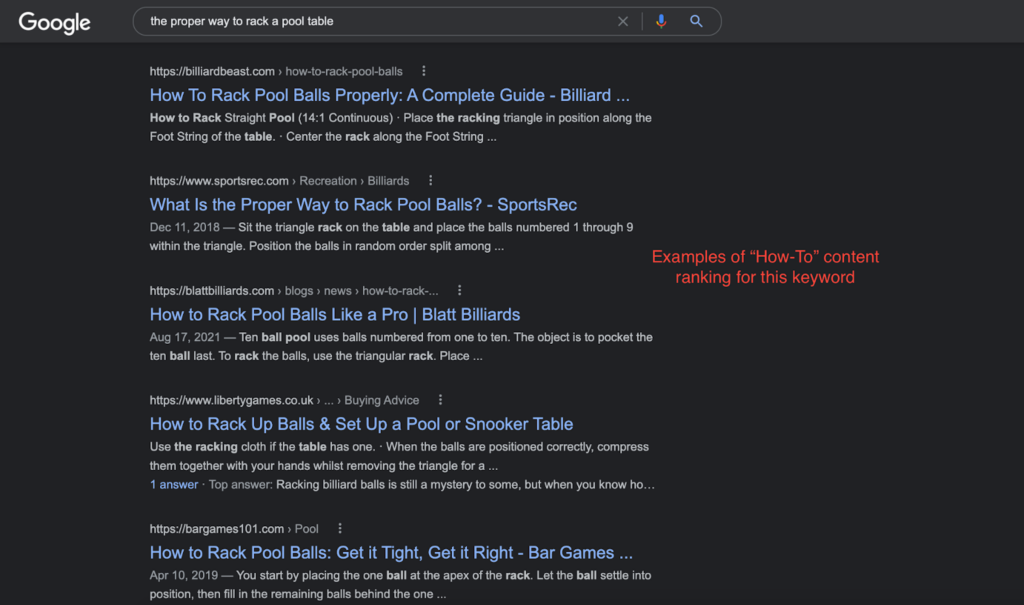
Content Creation
Now comes the fun stuff. Write your little heart out and pour out all the good stuff you’ve been dying to share with the world about your passion or business. If you want your page to be the number one result on Google, you better write something worthy of the number one position. Here are a few tips on how to do that.
Write an outline highlighting your major points
There should be a clear objective with every article you write. You should set out to accomplish a specific task and you can do this by writing an outline. Make your major points first. If you can read what’s going to be the major headings of your article and already get a general sense of what it explains, you’ve done a good job.
Make your content scan-able
People tend to skim through articles. Use H2 headings for your major points and break up your major points with smaller points using H3-H6 headings. This not only makes things easy to read but also summarizes your article beautifully for search engines by highlighting the important points.
WordPress actually provides you with a quick glance summary of your content when you’re “behind the scenes” writing or editing your article. Picture making your content like this when you’re doing your outline:
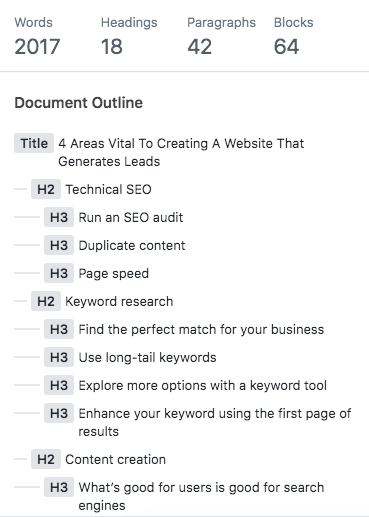
Use as much media as possible
Break up your text as much as possible with images and video. If you want to add audio-go right ahead. If you don’t have the perfect professional photo to illustrate your point-take a screenshot. An image every 300 words is a fantastic way to make your content much easier to digest.
According to a study in which 200 content marketers participated, a survey revealed that images were used in at least 48% of all content. Don’t forget that video and audio also give your audience more options for how they digest your content. This essentially creates more value than the average page.
Keep your language and vocabulary simple
Did you know that the average American reads at the eighth-grade level? Obviously, if you’re writing for a medical journal, things are going to get funky. Keep your writing extremely easy to understand and never assume people know what you’re talking about.
People will get frustrated and leave your website if they don’t understand what you’re talking about. Reserve your content for the masses and don’t exclude anyone by overcomplicating your text.
Use an app to boost the quality of your writing
Grammarly is a popular app that you can use to improve the overall quality of your writing. It not only corrects the spelling and grammar, but it also suggests different ways of wording sentences. That’s just the free version! If you opt for the paid version the software will do everything but write the article itself.
This isn’t the only piece of software you can use. There are amazing writing apps that offer different benefits depending on the style of your writing. These apps provide a great way to demonstrate professionalism when your copy always has flawless grammar and no misspelled words.
Just do better than what’s out there
At the end of the day, just do better than what’s out there. Be original because it goes a long way and make sure your article is better than what’s on the first page already. Make sure you’ve covered every aspect of the topic you’re writing about better than any other page. Give users more to look at and more to engage with on your page.
Optimize your content
You don’t have to go nuts with structured data markup (although it doesn’t hurt) but you do need to apply the basics of on-page optimization. This means strategically placing your keyword in the places search engines expect to find it. The following are the on-page optimization commandments:
Place your keyword in the title (the title should have an H1 heading)
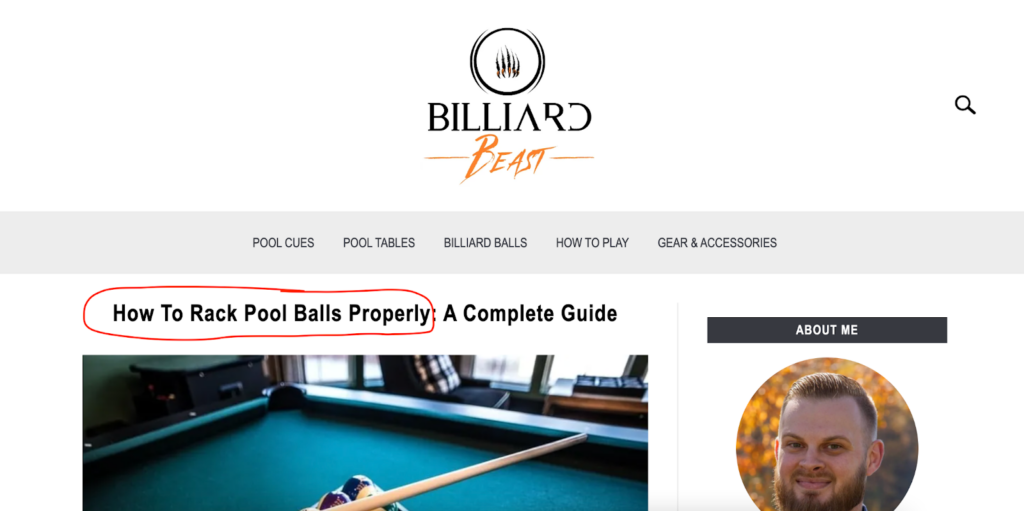
Your keyword should appear in the first paragraph or first 100 words

Repeat your keyword at least two or three times within the body
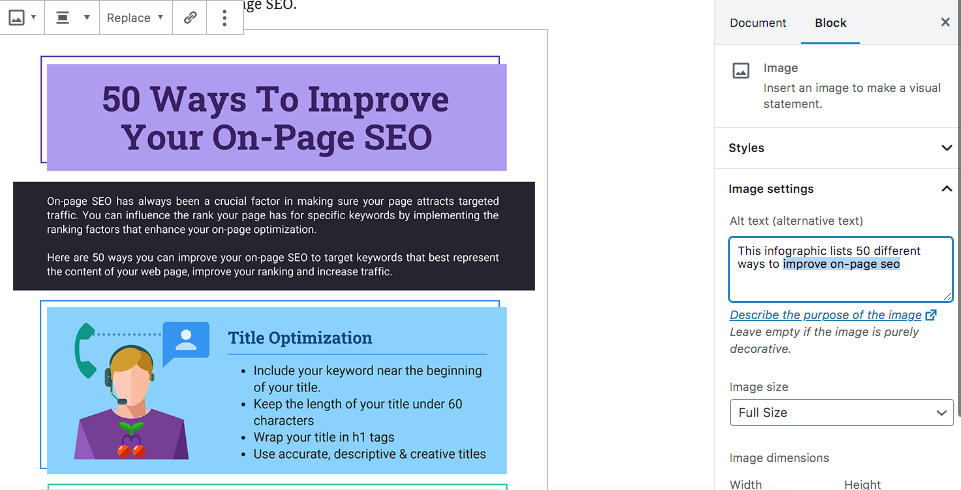
Include a meta description to describe your article in the search results

Build links to improve the ranking ability
Sometimes a page will rank with a well-written, well-optimized article. For difficult keywords, the final step on how to publish content that ranks in the search results is to build links to your page. Although link building is difficult, you don’t need to go to a San Francisco coding bootcamp to learn how. If we break it down to a few basic tips, most people can come up with a few great links in a relatively short amount of time.
How can people link to your page if they don’t know it exists? You will need to contact website owners that are likely to link to content like yours. If you know people in your industry or a close vertical to it, that’s one of the best places to start.
For example, if you’re a physiotherapist you could coordinate with a dentist to link to your page on TMJ therapy. There is a strong relationship to the content and it would be a great link if you’re both in the same city (consult a local SEO guide for more link-building tips if you’re a local business owner).
If you’re not sure how to find websites that will link to your website you can always spy on your competition to see who links to them.
Use software to uncover link opportunities
Tools that list your competition’s backlinks become invaluable when searching for link-building opportunities. Simply enter the URL of a page that ranks in the top 10 results for your keyword. Whether you’re using SEMrush or not, the results will look something like this:
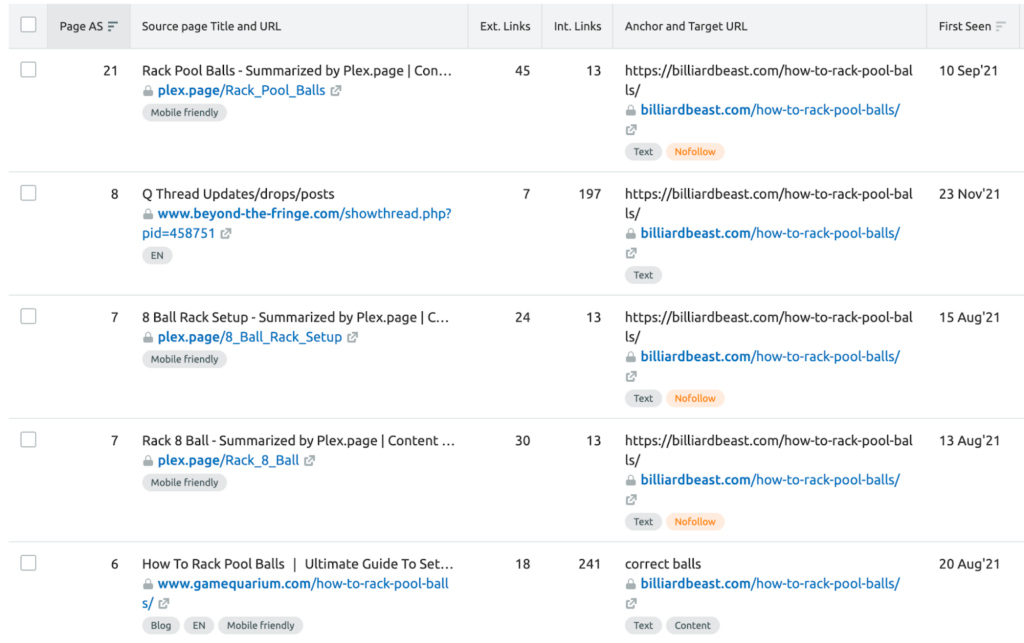
You now have a list of the websites that link to your competition. The next step is to reach out to each website to see if they will link to you as well. If your content is better than what’s out there you have a great shot at earning a link.
Use stats in your content
Give people more reasons to link to your page. Writers will often site their resources by linking to a page. You can pick up some great links by incorporating useful stats that writers will use in their own articles.
Use original images and charts
Everyone needs images for their content! If you’re using charts and screenshots and resourceful images, people will link to your page if they use the image. It’s how people operate now so use it to your advantage.
Final thoughts
There are many ways to generate traffic, but none pose as much potential as when you know how to publish content that ranks on Google. Your resources are limitless for as long as you can keep coming up with great ideas people want to read about. Follow the steps above and you’ll be well on your way to seeing success in the search results.






